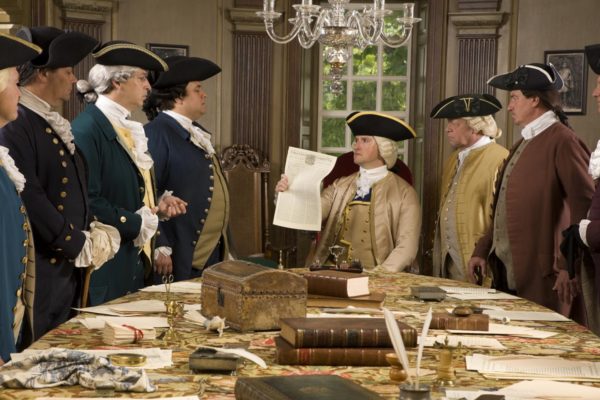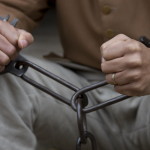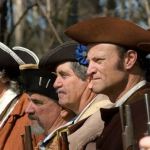Lord Dunmore is the cartoon villain of Williamsburg, the dastardly royal governor who tried to quash the Revolution, first by making off with the town’s gunpowder, then by offering freedom to slaves owned by Virginia’s rebels. But is there a more complicated truth beyond the moustache-twirling scoundrel?
It was on this date in 1775 when Dunmore ordered a detachment of British marines to whisk away 15 half-barrels of gunpowder from the Magazine under the cover of darkness.
After the alarm was raised early in the morning, angry residents assembled on Market Square and demanded answers. City fathers, led by Speaker of the House of Burgesses Peyton Randolph, confronted Dunmore at the Governor’s Palace. (This turn of events is reenacted in the Storming the Palace program).
The governor claimed the removal was merely to safeguard the colony’s supplies amidst rumors of an imminent slave uprising across the river in Surry. No one believed him, especially after word came that the first shots of the Revolution had been fired under strikingly similar circumstances on Lexington Green in Massachusetts the day before.
Within weeks, Dunmore would flee Williamsburg with his family, leaving behind many of his belongings and any prospect of salvaging his reputation.
This is an oft-told story: the governor who sided with the king and left in disgrace. What else is there to know? Well, here a few kernels selected from James Corbett David’s excellent biography of the man, Dunmore’s New World.
#1 His rise was somewhat unconventional
Before he was Lord Dunmore, he was just John Murray-a young man with limited formal education and an appointment in the Scots Guards. His father was a convicted traitor to the crown, having supported “Bonnie Prince Charlie” in the Jacobite uprising of 1745. Only a post-sentencing pardon preserved the family’s title.
When his uncle passed away without a male heir, John became the Fourth Earl of Dunmore in 1756. A few years later, frustrated by slow advancement, he abandoned his military career with the rank of captain at the age of 30.
His title landed him in the House of Lords, but it wasn’t until Lady Dunmore’s sister married Granville Leveson-Gower, the new president of the Privy Council, that his fortunes really turned. The connection yielded patronage, and even though Dunmore’s brother-in-law suspected he would need a keeper to be effective, he came through with a plum post in the American colonies.
#2 He tried to turn down the Virginia job
Dunmore was appointed governor of New York in 1770, where he had to deal with the colony’s intractable political factions, revolving around the DeLancey and Livingston families. But even after the unexpected death of Virginia’s governor, Norborne Berkeley, baron de Botetourt, offered him a way out, Dunmore still tried to resist a move to the largest and wealthiest American colony.
Dunmore was getting accustomed to New York and believed it was an influential post, even if it wasn’t the biggest. He had also staked a claim to 51,000 acres near Lake Champlain, which he hoped to make the basis for a family fortune. And everyone knew how unhealthy Virginia’s climate was.
Despite his stated preference for “health and good society to a greater salary,” Dunmore accepted his fate when William Tryon showed up unannounced to replace him.
#3 He was something of a carouser
Dunmore was known as a very social fellow who enjoyed hunting and target-shooting. One dinner guest described him as “a jolly, hearty companion, hospitable and polite at his own table.”
But he may have occasionally enjoyed himself a little too much. Soon after his arrival in New York, he was accused of offering drunken, bawdy toasts at a public occasion. One official close to him wondered if he was too much of a “blockhead” to lead the government with the requisite dignity.
Worse, as time passed without his wife and family joining him, he acquired a reputation as a womanizer. It’s unclear whether he really did anything to merit the label, but one British officer called him “a consummate rake,” and rumors of dalliances with young women repeatedly dogged him in Williamsburg.
#4 He planned to settle down in the colonies
Despite his delay in taking up residence in the colonies and in bringing his family to Williamsburg, Dunmore clearly had every intention of making a life in America, and not just because he named his daughter Virginia.
The governor’s economic prospects if he remained in Britain weren’t great. He was an indifferent member of the House of Lords, and neither he nor his wife came from great wealth. But like so many others who came to the Americas, he saw the potential for riches if he could acquire land.
In that sense, Dunmore had much in common with many of his fellow subjects. They were men on the make, doing whatever they could to acquire territory, even if it was beyond the Proclamation Line, west of which English settlement was supposed to be forbidden.
#5 He was no quitter

Dunmore has frequently been portrayed as a rogue who ran away from Virginia at the first opportunity he had.
After being chased from the Governor’s Palace, he could have gone right back to England and no one would have blamed him. But for months he lived on the William, an impressed merchant vessel, in the Elizabeth River not far from Norfolk, trying to find a way to defeat the rebels and return to office. The “floating town” of Loyalists and soldiers numbered as many as 200 vessels and some 3,000 people.
It was from here that Dunmore issued his infamous proclamation on Nov. 14, 1775, offering freedom to slaves who fought on the Loyalist side. More than 1,000 enslaved persons are believed to have fought in his Royal Ethiopian Regiment; many more women and children sought liberty under his protection. But this was evidence of his determination to win, not any abolitionist sentiments. Dunmore owned slaves, and as many as 150 worked his “Old Farm” in York County at any given time.
Eventually, Dunmore headed to New York, Not Britain. He joined Highlander and Hessian soldiers for the Battle of Long Island. During the subsequent British occupation of lower Manhattan he took up residence in a house on Broadway before finally embarking for the return voyage to Britain on Nov. 11, 1776.
But he wasn’t done yet. In early 1781 the British thought they had the upper hand and instructed Dunmore (and others) to reclaim his office as royal governor. Hopes for a triumphant return were dashed with news of the British surrender at Yorktown. The trip diverted to the Loyalist stronghold of Charleston, S.C.
His career concluded with a stint as governor of the Bahamas from 1787-1796. He died in 1809.
Dunmore was a character, but he wasn’t a cartoon. And as much as we would like to be certain of taking the “right” side if it were our decision to make, can we ever be sure?
Dunmore’s New World offers a nuanced portrait that will likely make you appreciate the vexing choices many people faced.




Spencer Chestnutt says
Dunmore certainly did not “accept his fate” when Tryon showed up in New York. First, he tried to get Tryon to go to Virginia and take the Governorship there while Dunmore would remain in New York, When that didn’t work, he had some very colorful things to say about what he thought of going to Virginia. Here’s the page from “Dunmore’s New World” that recounts that whole sordid episode.
https://books.google.com/books?id=V3qz3CccKc0C&pg=PP40&lpg=PP40&dq=lord+dunmore+damn+virginia+did+I+ever+seek+it&source=bl&ots=AHxYjj-TUv&sig=b2HLS8Uxn0oUVzDANHuZ_r_qdyo&hl=en&sa=X&ved=0ahUKEwjdhLHboL3MAhXIPD4KHed2Ci0Q6AEIKDAE#v=onepage&q=lord%20dunmore%20damn%20virginia%20did%20I%20ever%20seek%20it&f=false
I didn’t mean to suggest he was happy about it, only that he finally did go. As Jim says in the book, “He was to be governor of Virginia, and that was that.”
Hmm. Do I detect some loyalist sympathies lurking beneath your patriotic exterior, Bill? Just kidding. Nice piece. And good writing: “moustache-twirling scoundrel” — now there’s a compelling image.
Thomas E. Goode says
I love reading your blogs. I am a direct decedent of John Chesterfield Goode. He was one to the top horse breeders of the time and also bred the famous stallion Janus. John Chesterfield Goode was also one of the founders of the American Quarter Horse Breed.. A little know fact that is not well published. Quarter horse racing in colonial days was very popular. Perhaps do an article about that time. John Chesterfield Goode did not have an easy time as his horses were seized and requisitioned by Colonial militias and the British Army. If you ever need research information, I have access.
I would love to meet the horse riding staff and interpreters. I myself had years of experience with hoses.. Mostly quarter horses, but now have a thoroughbred. History repeating…
Respectfully,
Thomas E. Goode
Photo attached is of my Great Great Grandfather William O. Goode State Senator.. Sorry no images of John Chesterfield Goode